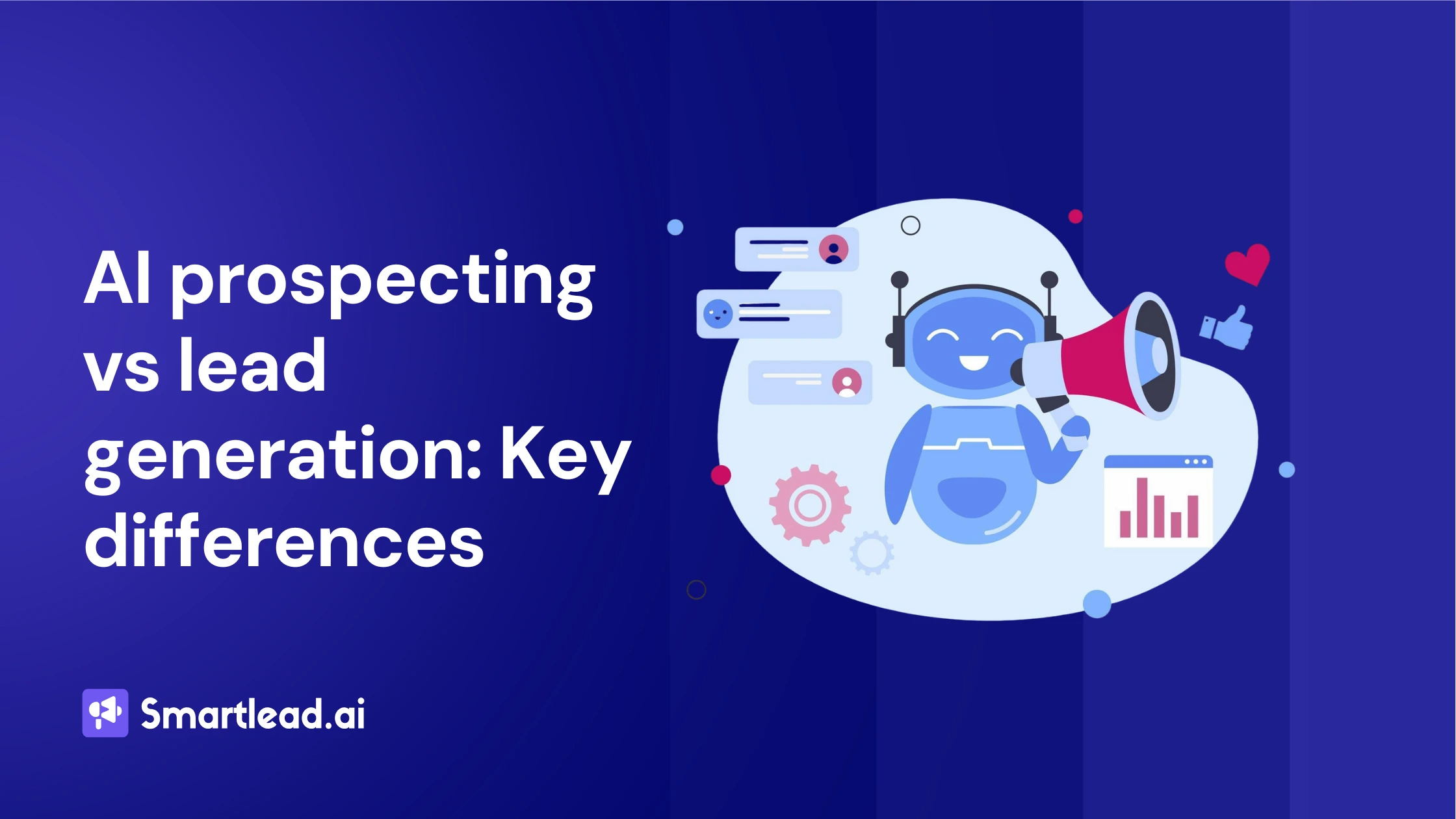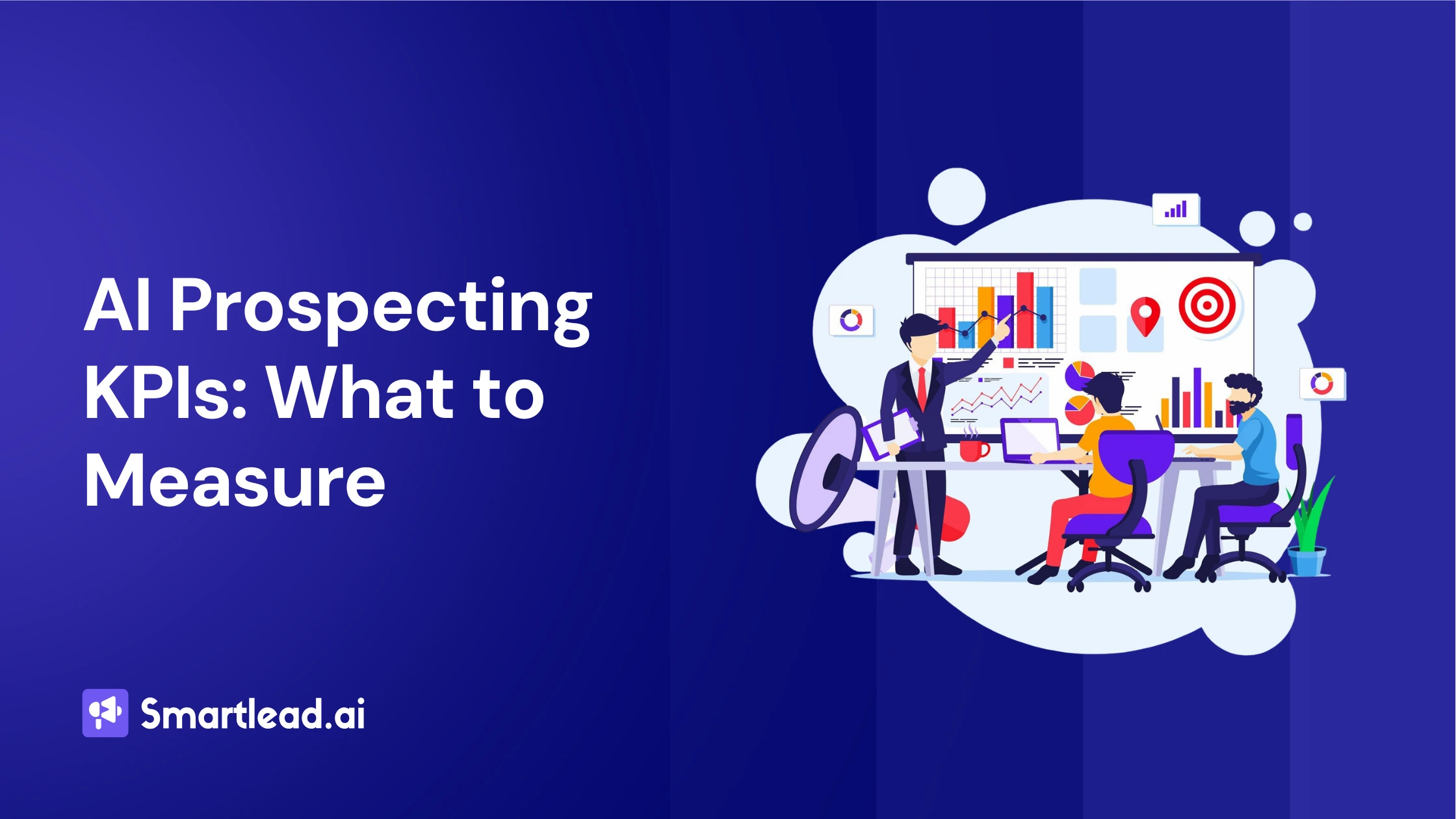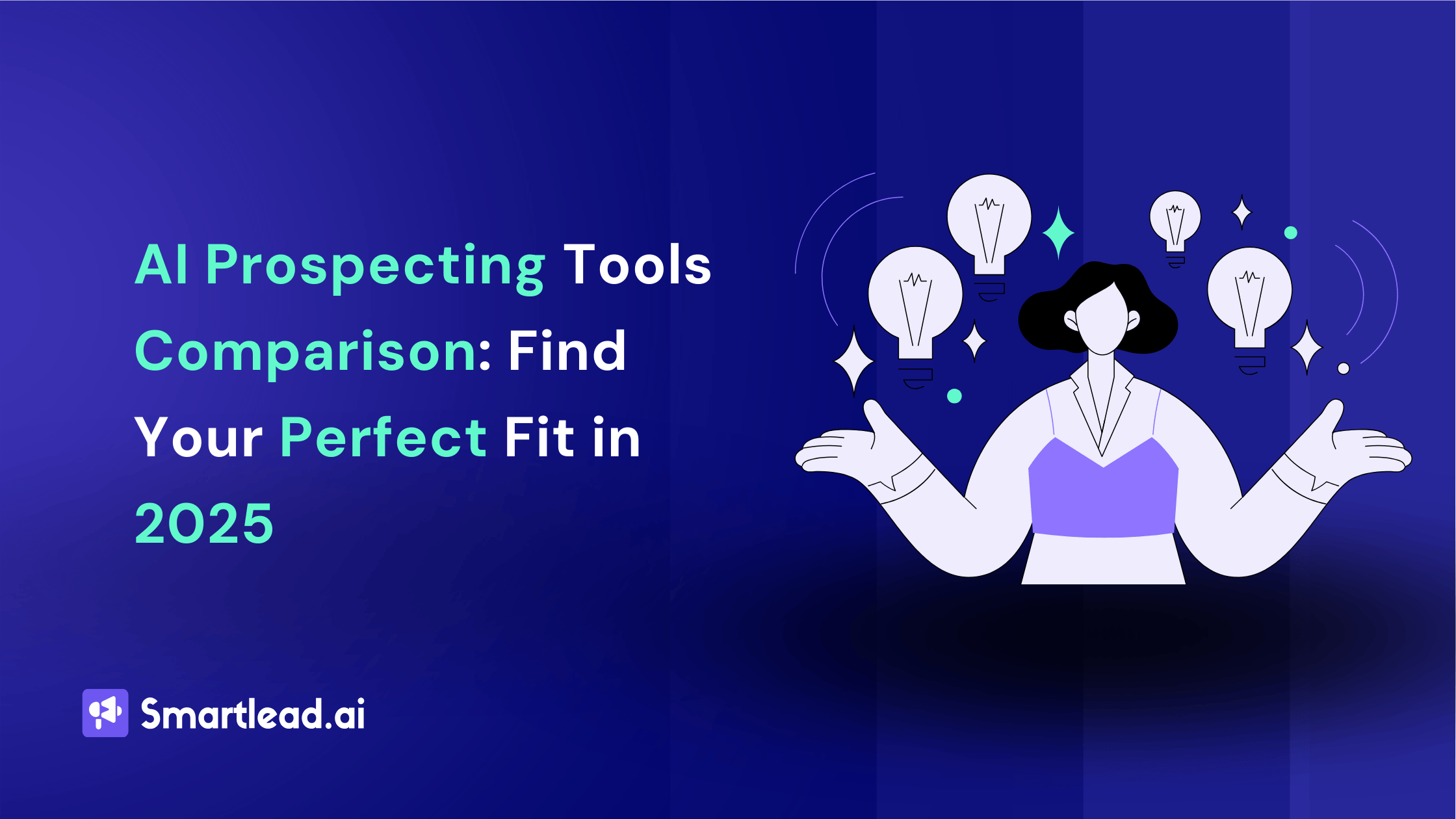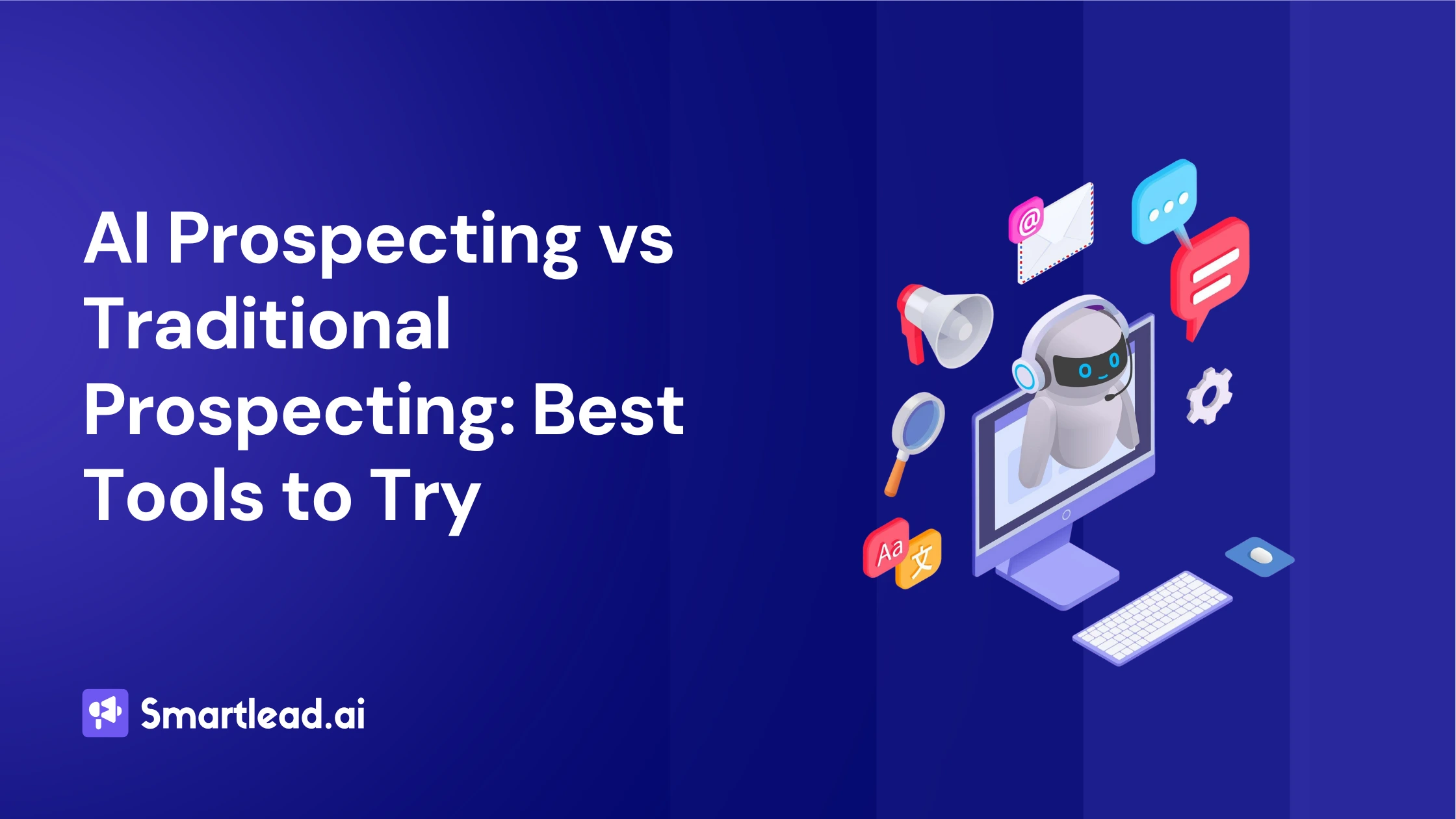AI Prospecting vs Lead Generation: Key Differences (And Why You're Probably Doing Both Wrong)

Heading
Prospecting vs lead generation comes down to who initiates the conversation. Lead generation is marketing attracting potential customers through content, ads, and SEO, then capturing their information when they express interest. Prospecting is sales actively hunting for potential customers who fit your ICP, researching them, and initiating direct outreach before they've shown any interest in you.
Lead generation says, "Here's valuable content, come find us." Prospecting says, "You fit our profile, I'm reaching out directly."
Here's why this distinction matters more than most teams realize: research shows 79% of marketing leads never convert into sales. When sales and marketing teams don't understand the difference between prospecting and lead generation, they create chaos. Marketing complains that sales don't follow up on leads. Sales complains marketing sends garbage leads. Both are right because they're solving different problems with incompatible approaches.
I've spent the last decade fixing this mess at companies ranging from scrappy startups to enterprise SaaS businesses. The pattern is always the same: teams confuse activity with strategy, use the terms interchangeably, and wonder why their pipeline is a disaster despite being "busy."
The Fundamental Difference Between Prospecting vs Lead Generation(That Nobody Explains Correctly)
Most articles about prospecting vs lead generation give you definitional differences then move on. That's useless. Let me show you what the difference actually looks like in practice.
Lead Generation: Inbound, Marketing-Owned, One-to-Many
Lead generation is your marketing team's domain. They create content, optimize SEO, run ads, host webinars, and build landing pages designed to attract people who are researching solutions to problems you solve.
When someone downloads your whitepaper, attends your webinar, or fills out a "request demo" form, they become a lead. They raised their hand. They came to you.
This is a one-to-many approach. You create one piece of content that attracts hundreds or thousands of potential buyers. It's passive in the sense that you're not reaching out individually. You're casting a wide net and seeing who swims in.
The goal of lead generation: create awareness, demonstrate expertise, and capture contact information from people who've shown interest in your category.
According to 6sense research, modern lead generation requires tracking buyer behavior without putting up speed bumps. Buyers don't want to fill out forms, so the best lead generation strategies track engagement with high-value content like product pages and detailed whitepapers, identifying warm leads through behavior rather than gated content.
Prospecting: Outbound, Sales-Owned, One-to-One
Prospecting is your sales team's domain. They identify specific companies and people who match your ICP, research them individually, and reach out directly via cold email, LinkedIn, or phone calls.
The prospects haven't raised their hands. They don't know you exist. You're initiating first contact based on the hypothesis that they might need what you sell.
This is a one-to-one approach (or at least it should be). You're not broadcasting to thousands. You're targeting specific accounts with personalized outreach based on actual research.
The goal of prospecting: identify high-fit potential customers, initiate conversations, and qualify them to determine if they're worth sales time.
As Lauren Petrullo, CEO and founder of Mongoose Media, describes it: "Lead generation is creating engaging content to attract a broader audience. Prospecting is the sniper approach. You're actually hunting for sales-qualified leads and targeting potential customers directly."
That hunting metaphor matters. Lead generation is setting traps and bait. Prospecting is tracking specific prey.
How AI Changes Both (But Differently)
AI fundamentally transforms both lead generation and prospecting, but in completely different ways. This is where most teams screw up, applying AI tactics from one discipline to the other.
AI in Lead Generation: Personalization at Scale and Predictive Scoring
AI makes lead generation smarter by analyzing which content resonates with which audiences, predicting which leads are most likely to convert, and personalizing content delivery based on behavior patterns.
Modern AI tools monitor website behavior, content engagement, and intent signals to identify leads showing genuine buying interest versus casual browsers. Instead of treating every whitepaper download equally, AI scores leads based on the combination of behaviors: visited pricing page + downloaded case study + watched demo video = high-intent lead.
This matters because quality beats quantity in lead generation. Organizations generate an average of 1,877 leads per month according to DemandSage research, but only 5% of salespeople rate marketing leads as "very high quality." AI helps marketing deliver better leads instead of just more leads.
The best lead generation AI also handles nurturing at scale. It identifies which leads need more education, which are ready for sales contact, and which have gone cold, then automatically delivers appropriate content to each segment.
AI in Prospecting: Research Automation and Intent Detection
AI transforms prospecting by handling the time-consuming research that previously made personalized outreach unscalable.
85% of salespeople say AI makes prospecting more effective, reducing wasted effort on low-quality leads. Here's what AI actually does in prospecting:
Identifies ideal prospects
AI analyzes your best customers, identifies patterns in firmographics and technographics, then surfaces lookalike companies matching those patterns.
Automates research
Instead of spending 15-20 minutes manually researching each prospect, AI gathers company news, hiring patterns, tech stack changes, funding rounds, and LinkedIn activity in seconds.
Detects buying intent
AI monitors when companies show signs they might be in-market for your solution: hiring for relevant roles, visiting competitor websites, engaging with category content, and increasing budget spend in your area.
Personalizes at scale
AI generates personalized talking points for each prospect based on their specific situation, removing the "personalization vs. scale" tradeoff that's plagued prospecting forever.
The game-changer is that AI lets you maintain prospecting's one-to-one personalization while reaching 5-10x more accounts. You're not choosing between quality and quantity anymore.
When to Use Lead Generation vs Prospecting (The Decision Framework)
Most companies should do both simultaneously, but the allocation depends on your specific situation. Here's the decision framework I use with clients:
Use Lead Generation When:
You're building category awareness
If potential buyers don't know solutions like yours exist, inbound content that educates the market works better than cold outreach. Nobody wants a sales call about a problem they don't know they have.
You have longer sales cycles
Enterprise B2B deals with 6-18 month sales cycles and benefit from lead generation that nurtures prospects over time as they research and build consensus. One cold call won't close a $500K deal with seven decision-makers.
You have high traffic potential
If you can rank for high-volume keywords in your category, SEO-driven lead generation captures people actively searching for solutions. That's warmer than any cold prospecting.
You're resource-constrained
Lead generation scales better than prospecting. One great piece of content can generate leads for years. Prospecting requires ongoing human effort for each account.
Your ICP is broad
If you serve many different industries, company sizes, and use cases, casting a wide lead gen net and seeing who responds is more efficient than trying to prospect everyone.
Use Prospecting When:
You need an immediate pipeline
Prospecting delivers faster results than lead generation. You can book meetings this week. SEO takes months to build. Content nurture takes quarters.
Your ICP is specific and narrow
If you target 500 companies in a defined segment, prospecting those specific accounts is more efficient than hoping they find your content.
You sell into mature markets
In crowded categories where buyers have lots of options, proactive prospecting positions you before they've engaged with competitors. Waiting for inbound means they've already built a shortlist without you.
You have high deal values
For $100K+ deals, the economics support intensive prospecting. Spending 10 hours researching and pursuing a single account makes sense if closing generates $150K in revenue.
Your solution requires education
Sometimes prospects don't know they need what you sell until you show them. Strategic prospecting initiates those conversations rather than waiting for them to discover the problem themselves.
Most successful B2B operations run both simultaneously: marketing generates inbound leads while sales proactively prospect target accounts. According to Martal Group research, when sales and marketing work collaboratively, 87% of professionals report essential business growth.
The Mistakes That Kill Both (Learned the Hard Way)
I've audited dozens of companies that are screwing up both lead generation and prospecting. Here are the patterns that keep repeating:
Mistake 1: Treating All Leads Like Prospects
Marketing generates 1,000 leads from a webinar. Sales treats them all like qualified prospects ready for demos. Conversion rate is 2%. Everyone's frustrated.
The problem: leads need nurturing. Most webinar attendees are early-stage researchers, not in-market buyers. Treating research-stage leads like sales-ready prospects burns relationships and wastes time.
The fix: implement lead scoring that distinguishes between information-gathering leads (need nurturing) and evaluation-stage leads (ready for prospecting). Different stages require different approaches.
Mistake 2: Prospecting Without Research
SDRs send 500 cold emails per day using generic templates with {FirstName} and {Company} personalization. Response rate is 1.5%. They call it "prospecting at scale."
That's not prospecting. That's spam with a sales justification.
Real prospecting requires research. Even AI-assisted research. You need to know why this specific person at this specific company might care about your solution right now. Without that context, you're not prospecting strategically.
Mistake 3: No Handoff Process Between Lead Gen and Prospecting
Marketing qualifies a lead as an MQL based on engagement score. Passes to sales. Sales looks at it, sees no buying intent, and ignores it. Lead dies in CRM purgatory.
The other instance when sales prospects an account, books a meeting. Later, it discovers marketing has been nurturing that same account for six months. Nobody communicated.
The gap between lead generation and prospecting kills deals. You need defined Service Level Agreements (SLAs) for when marketing-qualified leads (MQLs) become sales-qualified leads (SQLs), and visibility into which accounts each team is pursuing.
Mistake 4: Using the Same Metrics for Both
Teams track "leads generated" as if all leads are equal. They don't distinguish between an inbound trial signup (high intent, ready for sales) and someone who downloaded a top-of-funnel ebook (low intent, needs months of nurturing).
Or they measure prospecting success by activities (emails sent, calls made) instead of outcomes (meetings booked with qualified accounts, pipeline generated).
Lead generation metrics: traffic, conversion rates, MQL volume, lead quality score, nurture effectiveness.
Prospecting metrics: accounts contacted, response rates, meetings booked, SQL conversion, pipeline generated per hour of prospecting.
Different processes require different measurements.
The Tools That Actually Work (For Each)
Technology should clarify the distinction between lead generation and prospecting, not blur it further. Here's what works based on extensive testing:
Lead Generation Tools
For Content Creation and SEO
Semrush, Ahrefs for keyword research and content optimization. Clearscope for content briefs. ChatGPT/Claude for first-draft content that you then humanize and enhance.
For Landing Pages and Forms
Unbounce, Instapage for high-converting landing pages. Typeform for engaging forms that don't feel like forms. Drift for conversational landing page experiences.
For Lead Scoring and Nurturing
HubSpot, Marketo, or Pardot for marketing automation and lead scoring. 6sense or DemandBase for intent data that identifies which leads are actively researching.
For Attribution
Bizible, Dreamdata for understanding which lead gen channels actually drive revenue instead of just volume.
Prospecting Tools
For Identifying Prospects: LinkedIn Sales Navigator remains essential for building B2B prospect lists. Apollo.io and ZoomInfo for finding contact information and building lists based on specific criteria.
For Research and Intelligence
Clearbit for firmographic data. Lusha for contact enrichment. 6sense or Bombora for intent signals showing which accounts are in-market.
For Orchestration
Smartlead is the clear leader for multi-channel prospecting that coordinates email, LinkedIn, and calls intelligently. It's built specifically as a prospecting operating system rather than a lead generation tool adapted for outbound. The unified inbox, deliverability infrastructure, AI-powered personalization, and conditional sequencing make it the best choice for teams doing serious prospecting.

HeyReach and Expandi work well for LinkedIn-heavy prospecting when you need advanced account management..
For Call Intelligence
Gong, Chorus for analyzing prospecting calls and surfacing what messaging works. Dialpad for AI-powered call transcription and coaching.
The key: use lead generation tools for attraction and capture. Use prospecting tools for identification and outreach. Don't force tools designed for one purpose to handle the other.
The Integrated Approach: When Both Work Together
The best revenue operations don't pit lead generation against prospecting. They orchestrate both into a unified strategy where each amplifies the other.
Here's how that actually works in practice:
Marketing generates awareness through content
Your target accounts consume that content, even if they don't convert. When sales prospects those accounts later, they're not complete strangers. Recognition matters.
Sales provides feedback on lead quality
Prospecting conversations reveal what pain points are actually resonating, what objections come up repeatedly, and what messaging works. That intelligence informs better lead generation content.
Retargeting bridges both approaches
Prospects who don't respond to cold outreach see retargeting ads showcasing your content and social proof. Inbound leads who don't convert see retargeting that prompts them to engage with sales.
Account-Based Marketing (ABM) unifies both
For target accounts, marketing creates personalized content and campaigns while sales executes strategic prospecting. Both teams coordinate around the same account list rather than working independently.
I implemented this integrated approach with a B2B SaaS client last year. Previously, they had:
- Marketing generated 800 MQLs monthly, 12% became SQLs
- Sales prospecting 300 accounts monthly, 15% became SQLs
- Total: 1,100 accounts touched, 156 SQLs generated
After integration:
- Marketing identified 200 target accounts showing intent
- Created account-specific content for those 200
- Sales prospected the same 200 with context from marketing
- Marketing retargeted sales prospects who didn't respond
- Result: 200 accounts touched, 94 SQLs generated
They touched fewer accounts but generated 60% of the SQL volume from just 18% of the activity. That's the power of integrating lead generation and prospecting rather than treating them as separate functions.
The Future: How AI Blurs the Lines
AI is creating a new category that sits between traditional lead generation and prospecting: AI-powered account identification and orchestration.
Imagine this workflow (which already exists in advanced revenue operations):
- AI monitors thousands of companies for buying intent signals
- When a company shows intent, AI automatically triggers personalized lead generation content to them
- Simultaneously, AI surfaces that account for sales with research and talking points
- If they engage with content, marketing nurtures them
- If they don't engage with content, sales prospects them directly
- The approach adapts in real-time based on how the account responds
This isn't pure lead generation (you're targeting specific accounts). It's not pure prospecting (you're using content to attract, not just outbound). It's orchestrated revenue generation that uses the best of both approaches simultaneously.
The companies winning in 2025 don't debate prospecting vs lead generation. They use AI to determine which approach fits each account at each stage, then execute accordingly.
The Uncomfortable Truth About Both
Here's what nobody wants to hear: both lead generation and prospecting are getting harder.
Email open rates are declining as inboxes overflow. Content competition is fierce, with AI making it trivial to produce mediocre blog posts. Cold calling barely works, with 90%+ of calls going to voicemail. LinkedIn is saturated with prospectors.
The solution isn't doing more of the same tactics. It's being smarter about targeting, better at research, more strategic about personalization, and more disciplined about qualifying.
Lead generation works when you create genuinely valuable content for specific audiences with real problems. Generic SEO content that regurgitates what everyone else says doesn't generate quality leads anymore.
Prospecting works when you target the right accounts with relevant, personalized outreach based on actual research. Spamming 10,000 cold emails doesn't generate meetings with qualified prospects.
The bar is higher for both. Which means the teams that invest in doing it properly will see outsized returns while everyone else fights over scraps.
As Simon Bowen from The Models Method for Sales says, "Today's clients aren't just skimming for the lowest price. They're looking for the deep, meaningful connection that says you understand them."
That applies equally to lead generation content and prospecting outreach. Understanding requires research, empathy, and personalization. Whether they come to you or you go to them, the fundamentals don't change.

FAQs: Prospecting vs Lead Generation
What's the main difference between prospecting and lead generation?
Lead generation is marketing attracting potential customers through content and campaigns, waiting for them to express interest. Prospecting is sales actively identifying and reaching out to specific people who fit your ICP before they've shown interest. Lead gen is inbound and passive. Prospecting is outbound and active. Different teams, different approaches, different stages of the buyer journey.
Should I focus on lead generation or prospecting?
Both, but the allocation depends on your situation. Use lead generation if you're building awareness, have longer sales cycles, and serve broad markets. Use prospecting if you need an immediate pipeline, target specific accounts, and have high deal values. Most successful B2B companies run both simultaneously, with marketing handling lead gen and sales handling prospecting.
How does AI change prospecting vs lead generation?
AI makes lead generation smarter through predictive scoring, behavioral tracking, and automated nurturing that identify which leads are ready for sales. AI makes prospecting scalable by automating research, detecting buying intent, and personalizing outreach to hundreds of accounts while maintaining one-to-one quality. The core difference stays the same, but AI removes the tradeoffs between quality and scale.
Can the same tool handle both lead generation and prospecting?
Usually not well. Lead generation tools (HubSpot, Marketo) focus on content management, landing pages, and nurturing campaigns. Prospecting tools (Smartlead, Outreach, Salesloft) focus on outbound sequences, contact finding, and direct engagement. Using lead generation tools for prospecting or vice versa creates workflow mismatches. Build an integrated tech stack where each tool does what it's designed for.
Why do 79% of leads never convert to sales?
Most companies confuse leads with prospects. They treat every webinar attendee or content download as sales-ready when most are just researching. Without proper lead scoring, qualification, and nurturing, sales waste time on people who aren't ready to buy. The fix: implement clear criteria for when a lead becomes a sales-qualified lead (SQL), and nurture everyone else until they meet those criteria.
Author’s Details

Wajahat Ali
Wajahat Ali is a Technical Content Writer at Smartlead, specializing in the B2B and SaaS sectors. With a talent for simplifying complex concepts, he crafts clear, engaging content that makes intricate topics accessible to both experts and newcomers. Wajahat’s expertise spans across copywriting, social media content, and lead generation, where he consistently delivers valuable, impactful content that resonates with a global audience. His ability to blend technical knowledge with compelling storytelling ensures that every piece of content drives both understanding and results, helping businesses connect with their target markets effectively.
Edited by:
Lorem ipsum dolor sit amet, consectetur adipiscing elit. Suspendisse varius enim in eros elementum tristique. Duis cursus, mi quis viverra ornare, eros dolor interdum nulla, ut commodo diam libero vitae erat. Aenean faucibus nibh et justo cursus id rutrum lorem imperdiet. Nunc ut sem vitae risus tristique posuere.
Frequently asked questions
What is Smartlead's cold email outreach software?

Smartlead's cold email outreach tool helps businesses scale their outreach efforts seamlessly. With unlimited mailboxes, fully automated email warmup functionality, a multi-channel infrastructure, and a user-friendly unibox, it empowers users to manage their entire revenue cycle in one place. Whether you're looking to streamline cold email campaigns with automated email warmups, personalization fields, automated mailbox rotation, easy integrations, and spintax, improve productivity, or enhance scalability with subsequences based on lead’s intentions, automated replies, and full white-label experience, our cold email tool implifies it in a single solution.
What is Smartlead, and how can it enhance my cold email campaigns?

Smartlead is a robust cold emailing software designed to transform cold emails into reliable revenue streams. Trusted by over 31,000 businesses, Smartlead excels in email deliverability, lead generation, cold email automation, and sales outreach. A unified master inbox streamlines communication management, while built-in email verification reduces bounce rates.
Additionally, Smartlead offers essential tools such as CNAME, SPF Checker, DMARC Checker, Email Verifier, Blacklist Check Tool, and Email Bounce Rate Calculator for optimizing email performance.
How does Smartlead's unlimited mailboxes feature benefit me?

Our "unlimited mailboxes" feature allows you to expand your email communications without restrictions imposed by a mailbox limit. This means you won't be constrained by artificial caps on the number of mailboxes you can connect and use. This feature makes Smartlead the best cold email software and empowers you to reach a wider audience, engage with more potential customers, and manage diverse email campaigns effectively.
How does Smartlead, as a cold emailing tool, automate the cold email process?

Smartlead’s robust cold email API and automation infrastructure streamline outbound communication by transforming the campaign creation and management processes. It seamlessly integrates data across software systems using APIs and webhooks, adjusts settings, and leverages AI for personalised content.
The cold emailing tool categorises lead intent, offers comprehensive email management with automated notifications, and integrates smoothly with CRMs like Zapier, Make, N8N, HubSpot, Salesforce, and Pipedrive. Smartlead supports scalable outreach by rapidly adding mailboxes and drip-feeding leads into active campaigns Sign Up Now!
What do you mean by "unibox to handle your entire revenue cycle"?

The "unibox" is one of the unique features of Smartlead cold email outreach tool, and it's a game-changer when it comes to managing your revenue cycle. The master inbox or the unibox consolidates all your outreach channels, responses, sales follow-ups, and conversions into one centralized, user-friendly mailbox.
With the "unibox," you gain the ability to:
1. Focus on closing deals: You can now say goodbye to the hassle of logging into multiple mailboxes to search for replies. The "unibox" streamlines your sales communication, allowing you to focus on what matters most—closing deals.
2. Centralized lead management: All your leads are managed from one central location, simplifying lead tracking and response management. This ensures you take advantage of every opportunity and efficiently engage with your prospects.
3. Maintain context: The "unibox" provides a 360-degree view of all your customer messages, allowing you to maintain context and deliver more personalized and effective responses.
How does Smartlead ensure my emails don't land in the spam folder?

Smartlead, the best cold email marketing tool, ensures your emails reach the intended recipients' primary inbox rather than the spam folder.
Here's how it works:
1. Our "unlimited warmups" feature is designed to build and maintain a healthy sending reputation for your cold email outreach. Instead of sending a large volume of emails all at once, which can trigger spam filters, we gradually ramp up your sending volume. This gradual approach, combined with positive email interactions, helps boost your email deliverability rates.
2. We deploy high-deliverability IP servers specific to each campaign.
3. The ‘Warmup’ feature replicates humanized email sending patterns, spintax, and smart replies.
4. By establishing a positive sender reputation and gradually increasing the number of sent emails, Smartlead minimizes the risk of your emails being flagged as spam. This way, you can be confident that your messages will consistently land in the primary inbox, increasing the likelihood of engagement and successful communication with your recipients.
Can Smartlead help improve my email deliverability rates?

Yes, our cold emailing software is designed to significantly improve your email deliverability rates. It enhances email deliverability through AI-powered email warmups across providers, unique IP rotating for each campaign, and dynamic ESP matching.
Real-time AI learning refines strategies based on performance, optimizing deliverability without manual adjustments. Smartlead's advanced features and strategies are designed to improve email deliverability rates, making it a robust choice for enhancing cold email campaign success.
What features does Smartlead offer for cold email personalisation?

Smartlead enhances cold email personalisation through advanced AI-driven capabilities and strategic integrations. Partnered with Clay, The cold remaining software facilitates efficient lead list building, enrichment from over 50 data providers, and real-time scraping for precise targeting. Hyper-personalised cold emails crafted in Clay seamlessly integrate with Smartlead campaigns.
Moreover, Smartlead employs humanised, natural email interactions and smart replies to boost engagement and response rates. Additionally, the SmartAI Bot creates persona-specific, high-converting sales copy. Also you can create persona-specific, high-converting sales copy using SmartAI Bot. You can train the AI bot to achieve 100% categorisation accuracy, optimising engagement and conversion rates.
Can I integrate Smartlead with other tools I'm using?

Certainly, Smartlead cold email tool is designed for seamless integration with a wide range of tools and platforms. Smartlead offers integration with HubSpot, Salesforce, Pipedrive, Clay, Listkit, and more. You can leverage webhooks and APIs to integrate the tools you use. Try Now!

Is Smartlead suitable for both small businesses and large enterprises?
Smartlead accommodates both small businesses and large enterprises with flexible pricing and comprehensive features. The Basic Plan at $39/month suits small businesses and solopreneurs, offering 2000 active leads and 6000 monthly emails, alongside essential tools like unlimited email warm-up and detailed analytics.
Marketers and growing businesses benefit from the Pro Plan ($94/month), with 30000 active leads and 150000 monthly emails, plus a custom CRM and active support. Lead generation agencies and large enterprises can opt for the Custom Plan ($174/month), providing up to 12 million active lead credits and 60 million emails, with advanced CRM integration and customisation options.

What type of businesses sees the most success with Smartlead?
No, there are no limitations on the number of channels you can utilize with Smartlead. Our cold email tool offers a multi-channel infrastructure designed to be limitless, allowing you to reach potential customers through multiple avenues without constraints.
This flexibility empowers you to diversify your cold email outreach efforts, connect with your audience through various communication channels, and increase your chances of conversion. Whether email, social media, SMS, or other communication methods, Smartlead's multi-channel capabilities ensure you can choose the channels that best align with your outreach strategy and business goals. This way, you can engage with your prospects effectively and maximize the impact of your email outreach.

How can Smartlead integrate with my existing CRM and other tools?
Smartlead is the cold emailing tool that facilitates seamless integration with existing CRM systems and other tools through robust webhook and API infrastructure. This setup ensures real-time data synchronisation and automated processes without manual intervention. Integration platforms like Zapier, Make, and N8N enable effortless data exchange between Smartlead and various applications, supporting tasks such as lead information syncing and campaign status updates. Additionally, it offers native integrations with major CRM platforms like HubSpot, Salesforce, and Pipedrive, enhancing overall lead management capabilities and workflow efficiency. Try Now!

Do you provide me with lead sources?
No. Smartlead distinguishes itself from other cold email outreach software by focusing on limitless scalability and seamless integration. While many similar tools restrict your outreach capabilities, Smartlead offers a different approach.
Here's what makes us uniquely the best cold email software:
1. Unlimited Mailboxes: In contrast to platforms that limit mailbox usage, Smartlead provides unlimited mailboxes. This means you can expand your outreach without any arbitrary constraints.
2. Unique IP Servers: Smartlead offers unique IP servers for every campaign it sends out.
3. Sender Reputation Protection: Smartlead protects your sender reputation by auto-moving emails from spam folders to the primary inbox. This tool uses unique identifiers to cloak all warmup emails from being recognized by automation parsers.
4. Automated Warmup: Smartlead’s warmup functionality enhances your sender reputation and improves email deliverability by maintaining humanised email sending patterns and ramping up the sending volume.

How secure is my data with Smartlead?
Ensuring the security of your data is Smartlead's utmost priority. We implement robust encryption methods and stringent security measures to guarantee the continuous protection of your information. Your data's safety is paramount to us, and we are always dedicated to upholding the highest standards of security.
How can I get started with Smartlead?

Getting started with Smartlead is straightforward! Just head over to our sign-up page and follow our easy step-by-step guide. If you ever have any questions or need assistance, our round-the-clock support team is ready to help, standing by to provide you with any assistance you may require. Sign Up Now!
How can I reach the Smartlead team?

We're here to assist you! You can easily get in touch with our dedicated support team on chat. We strive to provide a response within 24 hours to address any inquiries or concerns you may have. You can also reach out to us at support@smartlead.ai








